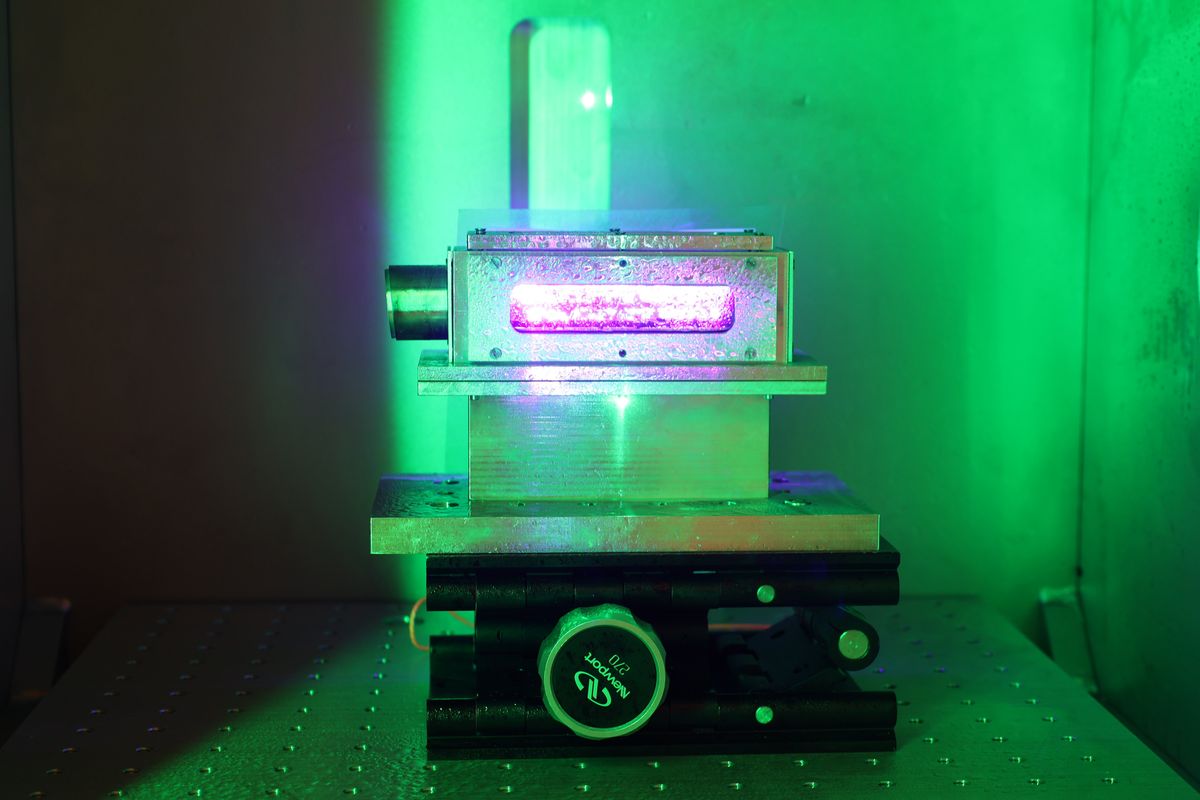Until recently, there were only two operational U.S. particle accelerators capable of producing electron beams with energies of 10 billion electron volts or more, machines that are both roughly 3 kilometers long. Now, in a new study, researchers have unveiled one just 10 centimeters long. The powerful compact particle accelerators that could result from this advance might find applications such as cancer therapies and 3D imaging of new 3D chip designs, the scientists add.
The concept behind the new device was first described in 1979. An extremely powerful laser strikes a gas, producing a plasma, while waves in the plasma kick electrons out in a high-energy beam.
The laser coalesces a petawatt of power—1,000 times the installed electrical power in the U.S.—into a mere 150-femtosecond pulse—one billionth the duration of a lightning bolt.
These “wakefield accelerators“ are capable of imparting inertia to individual electrons at some 1,000 times the efficiency of what is possible using conventional, kilometer-scale particle smashers. Scientists have long suggested that wakefield accelerators could shrink kilometer-scale facilities to room-size or smaller.
A key problem that wakefield accelerators face is how much their electron beams can fluctuate in their properties due to small variations in the laser and gas conditions. In the new study, the researchers sought to improve the stability of wakefield accelerators using nanoparticles.
The researchers started by shooting a laser pulse at an aluminum plate inside a chamber filled with helium. This generated a cloud of aluminum particles, each roughly 10 nanometers wide inside the gas.
The scientists then fired one of the world’s most powerful pulsed lasers, the Texas Petawatt Laser in Austin, at the mix of gas and nanoparticles in the chamber. The machine can fire a single petawatt laser pulse every hour. The burst coalesces that single petawatt—1,000 times the installed electrical power in the U.S.—into a mere 150-femtosecond pulse—one billionth the duration of a lightning bolt.
“They’ll become the cutting-edge research tools for everything from material science, bio, chemistry, and more. They will enable critical research for new batteries, solar cells, designer pharmaceuticals, vaccines, drugs, and hundreds of other industries”
—Bjorn Manuel Hegelich, University of Texas at Austin
The nanoparticles help boost the energy delivered from the plasma waves to the electrons. This gets more electrons surfing the waves when and where they are needed, says study senior author Bjorn Manuel Hegelich, a physicist at the University of Texas at Austin.

Hegelich’s group’s new accelerator was capable of delivering 10 billion electron volt (10-GeV) electron beams. It could also generate lower-energy beams in the 4 GeV to 6 GeV range.
Based on previous results with a smaller laser, the scientists expected more modest results. “Instead, we saw a five times higher energy,” Hegelich says. He is also founder and CEO of TAU Systems, which holds the exclusive license for the patent applied for this new device.
Near-term applications for lower-energy beams include 3D imaging of new 3D chip designs, electron therapies for cancer, radiation testing of space-bound electronics, “and also diagnostics, where it enables new methods like X-ray induced acoustic computed tomography,” Hegelich says.
Scientists hope to increase the shot rate “from one shot per hour to about 100 shots per second and then more than 10,000 shots per second.”
The big application for a 10 billion electron volt beam is to drive X-ray-free electron lasers, which are “the ultimate X-ray microscopes, achieving molecular resolution in both space and time,” Hegelich says. “They’ll become the cutting-edge research tools for everything from material science, bio, chemistry, and more. They will enable critical research for new batteries, solar cells, designer pharmaceuticals, vaccines, drugs, and hundreds of other industries.”
There are currently only a few of these lasers available worldwide, “which means there is very limited access and available time on them,” Hegelich says. He adds that their research could shrink these machines “from campus to lab size, so you could have one at every large university and even in companies. This will democratize access, making beam time accessible to more research and industry than ever previously possible.”
The main challenge the scientists faced in the course of their research was the fact that the Texas Petawatt Laser only fires about four to five times per day, and laser parameters such as energy and pulse duration “can fluctuate quite a bit, as parts of the system are quite old,” Hegelich says. “We typically get only one or two good shots per day, and overall statistics are quite poor.”
In the future, the scientists want to repeat their research using a smaller laser with a higher shot rate to gather data that can help them “precisely control this new mechanism,” Hegelich says. They would like to increase the shot rate “from one shot per hour to about 100 shots per second and then more than 10,000 shots per second,” Hegelich says.
Such research could scale this nanoparticle-based accelerator “down to a lower laser-pulse energy whilst retaining the advantages we observed,” Hegelich says. “This will allow us to reach higher electron energies with a given laser, or reach a target electron energy with a smaller laser.”
The scientists detailed their findings in the journal Matter and Radiation at Extremes.
- A Particle Accelerator the Size of a Sewing Needle - IEEE Spectrum ›
- Particle Accelerator on a Chip Hits Penny-Size ›
- Plasma Wakefield Particle Accelerators Go Commercial - IEEE Spectrum ›
Charles Q. Choi is a science reporter who contributes regularly to IEEE Spectrum. He has written for Scientific American, The New York Times, Wired, and Science, among others.



